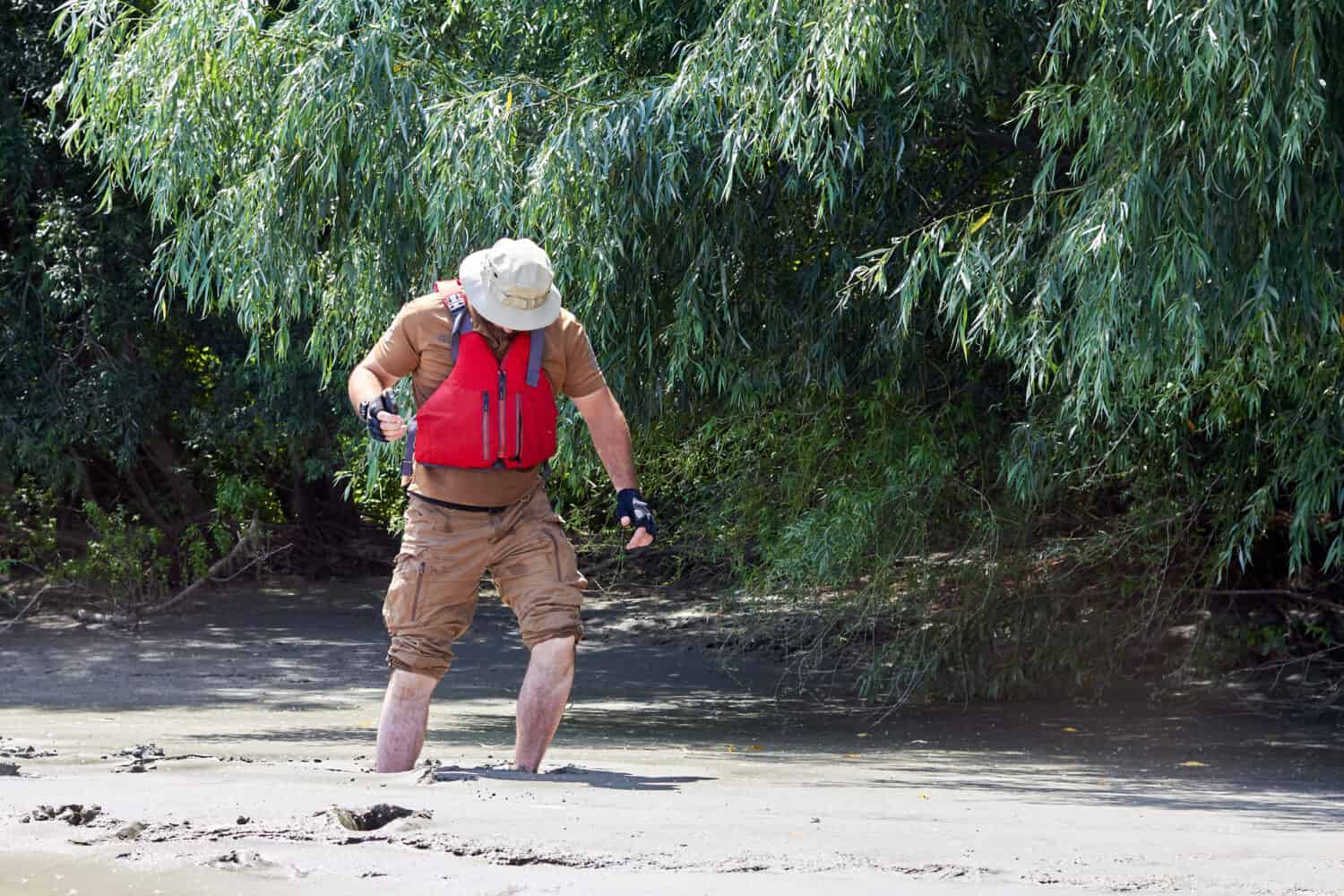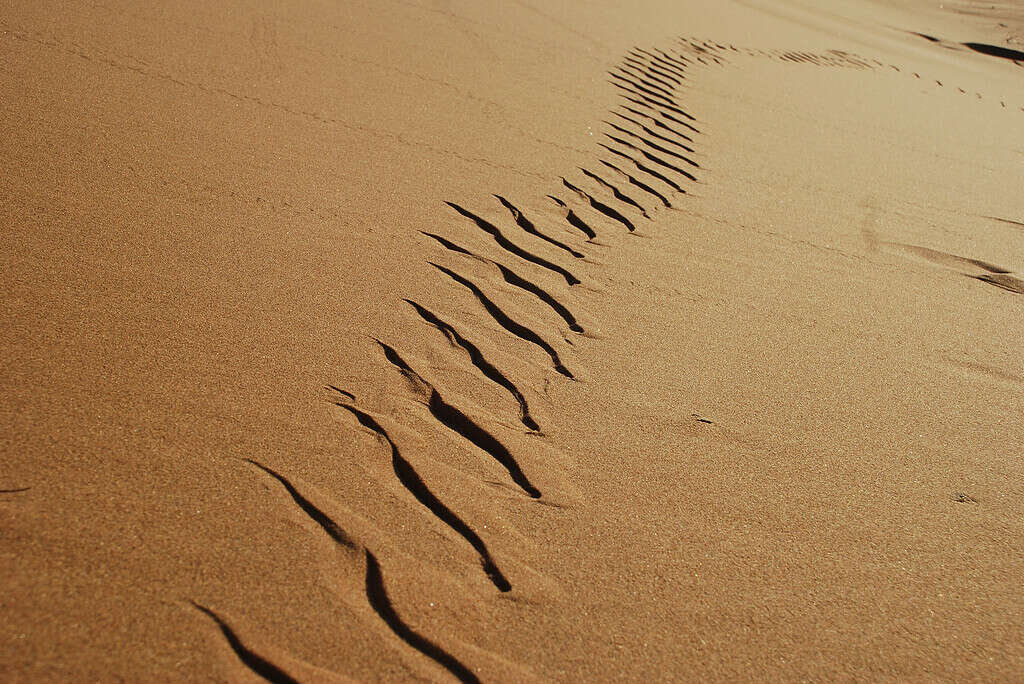This article provides a brief overview of the most common places quicksand is found. It highlights how people often have misconceptions about quicksand and offers tips on how to safely navigate these areas if encountered. Overall, the article serves as a helpful guide for anyone interested in learning more about this natural phenomenon.
What is Quicksand?

Quicksand is not only made of sand. It can be soil, dirt, clay, or other minerals.
©watcher fox/Shutterstock.com
Quicksand is a natural phenomenon that occurs when sand or silt particles become saturated with water, creating a liquefied state. It can be found in various locations, such as riverbanks, beaches, and marshes. Quicksand has a deceiving appearance. It often looks like regular wet sand but has the unique ability to trap objects or people who step on it.
Quicksand’s properties are what make it dangerous and unpredictable. Unlike solid ground, quicksand lacks stability due to its liquefied state. Objects or individuals that come into contact with quicksand will sink deeper the more they struggle against it due to its high viscosity. The weight of an object combined with the upward pressure of water beneath the surface creates an increased force that makes extraction difficult.
It is important to note that not all sinking substances qualify as quicksand. Some may look similar but have different characteristics and behaviors. For instance, mudflats can also trap individuals similarly to quicksand but do not create suction forces like those experienced in true quicksand.
In summary, understanding what quicksand looks like and how it behaves is crucial for anyone exploring areas where this phenomenon exists. Knowing these details can help avoid potential dangers associated with being trapped in this unstable terrain while enjoying outdoor activities safely.
Where is it Found?

Quicksand is found in marshes and swamps, and other wet areas.
©iStock.com/epantha
Quicksand can be found in various countries and locations around the world. Some of the most common places where quicksand is found include coastal regions, riverbanks, marshes, and swamps. These areas are characterized by loose sandy soil that becomes saturated with water.
Quicksand tends to form near bodies of water such as rivers, lakes, or oceans due to their fluctuating tides. The constant movement of the water causes sand particles to loosen up and mix with water creating a viscous mixture known as quicksand.
In addition to natural bodies of water, man-made structures such as dams and irrigation channels can also create conditions for quicksand formation. When these structures become damaged or worn down over time, they can lead to changes in local hydraulic systems resulting in pockets of quicksand.
Not all sandy soils will result in quicksand formation. Factors such as grain size distribution, compaction level, moisture content, and other physical properties dictate whether the soil will turn into quicksand when wet.
Therefore it’s essential for anyone exploring outdoor terrains, especially those located near bodies of water, should exercise caution while traversing through them, remembering that not all seemingly stable-looking surfaces may actually be safe footing ground.
Myths

Contrary to popular myth, quicksand is not found in the desert.
©Piece of peace/Shutterstock.com
Myth #1. There is Quicksand in the Desert. – Despite what Hollywood may have led you to believe, quicksand is not typically found in desert environments. This popular myth has been perpetuated through countless movies and TV shows, but the reality is that water is a critical component for the formation of quicksand.
In order for quicksand to form, there must be flowing water underground that agitates the sand particles. This agitation causes the sand to lose its stability and become liquefied, creating a dangerous trap for anything or anyone who steps into it.
It’s important to dispel this myth about quicksand because it can lead people to underestimate the real dangers posed by this natural phenomenon. By understanding how and where quicksand typically forms (i.e., near bodies of water), individuals can take appropriate precautions when exploring unfamiliar terrain.
Myth #2 Quicksand is Only Made From Sand – When most people hear the term “quicksand,” they immediately think of a dangerous pit of sinking sand that can swallow them up in an instant. However, this is not entirely accurate. Quicksand is actually a bit of a misnomer, as it can be made up of various materials other than just sand. In fact, any mass of clay, sand, or dirt particles that contains trapped water can turn into quicksand.
What happens is that the presence of water turns the solid particles into thick liquid mud that has little strength to support the weight. This means that when someone steps on top of quicksand or tries to move through it quickly, their weight causes the ground beneath them to collapse and liquefy further. The person then sinks deeper into the muck before eventually coming to rest at some point below its surface.
One thing about quicksand is that it often looks deceivingly stable and solid from above, even though it’s anything but upon closer inspection. Unlike typical mud, which may look wet and squishy from afar, quicksand often appears more like dry land until someone tries to step through it or apply pressure on its surface.
Myth #3 Quicksand is Very Deep – While movies may depict quicksand as a dangerous and deadly force, in reality, it is more of a messy inconvenience than a life-threatening hazard. Quicksand is typically only a few feet deep, and while still difficult to navigate, it can often be escaped with relative ease.
However, exhaustion from trying to untangle oneself from the waterlogged soil remains the biggest risk associated with being caught in quicksand. It can take an immense amount of physical energy to free oneself from its grasp, which makes it important to stay calm and avoid panicking if you find yourself stuck.
Remember that quicksand does not suck you under like some sort of vacuum but instead creates suction around your legs, making them feel heavy and immobile. By slowly working one leg at a time out of the sand or using nearby objects like branches or ropes for leverage, individuals can safely extract themselves without succumbing to exhaustion or panic-induced mistakes.
Is Quicksand Dangerous?
One of the most common questions that arise when discussing quicksand is whether or not it poses a serious danger to individuals. While many people may have heard stories about individuals becoming trapped in quicksand and being unable to escape, the reality is that deaths from this phenomenon are relatively rare.
According to statistics, there are only a handful of fatalities worldwide each year related to quicksand. This fact can be attributed in part to the fact that modern technology has made it easier for rescue teams to locate and extract individuals who become trapped in these conditions.
However, while the risk of death from quicksand may be low, it’s important for individuals who venture into areas where such conditions exist to take appropriate precautions and exercise caution at all times. This might include avoiding areas with unstable terrain or carrying safety equipment like ropes or flotation devices in case an emergency situation does arise.
While quicksand is often portrayed as a treacherous and deadly hazard in popular culture, the reality is that it poses relatively little danger to most people. In fact, much of the fear surrounding quicksand can be attributed to Hollywood movies and other works of fiction that have sensationalized this natural phenomenon.
How to Get Out of Quicksand
Escaping quicksand may seem like a daunting task, but it’s actually quite simple. The most important thing to remember is not to panic. Quicksand is not as dangerous as often portrayed in movies and TV shows.
To escape quicksand, you should first try to distribute your weight evenly by lying on your back or leaning back if possible. This will help prevent sinking deeper into the sand.
Next, slowly move your legs in a swimming motion toward the surface while keeping them as straight as possible. Avoid jerking or making sudden movements that could cause more suction.
If you have someone with you, they can throw you a rope or extend a branch for you to grab onto and pull yourself out of the quicksand.
Struggling too much can make things worse and increase the risk of sinking deeper into the sand. Staying calm and following these steps will greatly increase your chances of escaping unharmed. Do not reach your arms down into the quicksand or bend over. Take deep breaths and move slowly. Try to lighten your load by removing heavy backpacks or jackets.
Remember, prevention is always better than cure when it comes to avoiding getting stuck in quicksand. Keep an eye out for warning signs, such as areas where water flows through sediment deposits or near riverbanks after heavy rainfall.
Summary of the Most Common Places Quicksand Is Found
| Number | Quicksand Locations |
|---|---|
| 1 | Riverbanks |
| 2 | Beaches |
| 3 | Marshes |
| 4 | Coastal regions |
| 5 | Swamps |
| 6 | Rivers |
| 7 | Lakes |
| 8 | Oceans |
| 9 | Dams |
| 10 | Irrigation Channels |
The photo featured at the top of this post is © John Corry/Shutterstock.com
Thank you for reading! Have some feedback for us? Contact the AZ Animals editorial team.






